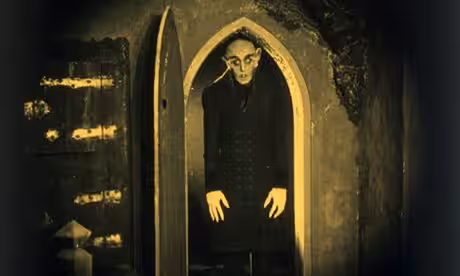Since the dawn of early cinema, Count Dracula has appeared in hundreds of films. However, audiences were first introduced to Bram Stoker’s iconic vampire through F.W. Murnau’s Nosferatu, an unofficial silent adaptation that altered the novel’s names and details to sidestep copyright issues. Instead of joining the ranks of traditional Dracula adaptations, American filmmaker Robert Eggers chose to remake Nosferatu and he has a compelling reason for focusing on this iconic horror classic for his next project.
Given that Nosferatu is essentially an unofficial take on Dracula, one might assume Eggers would prefer to adapt Stoker’s celebrated novel directly. However, the historical horror director explained to Screen Rant why remaking Murnau’s silent masterpiece was the perfect choice for him.
Robert Eggers sat down for an interview, his enthusiasm for classic horror evident as he explained his decision to remake Nosferatu instead of diving into a direct adaptation of Bram Stoker’s Dracula.
“As much as I love the novel,” he began, “it’s a bit overstuffed with Victoriana.” He paused, clearly weighing the weight of his words about such an iconic work. “There’s something about Murnau’s Nosferatu that strips it down, turning it into a simple fairy tale.”
That simplicity, he explained, was what drew him in. “I think that core fairy tale, the one buried beneath all the layers of the Stoker novel, is what makes it so adaptable. It’s why Dracula has inspired so many creators for over a century. But with Nosferatu, it’s like uncovering the essence of that story in its purest form.”

For Eggers, it wasn’t just about creating another vampire film. It was about rediscovering the primal tale that had captivated audiences since the silent film era—and breathing new life into it.
Honestly, it’s easy to see where Eggers is coming from. A story that’s “overstuffed with Victoriana” might not connect with modern audiences, and it doesn’t seem to be the type of narrative he’s eager to tell. Eggers’ previous films have delved into folklore and myth—The Witch explored Puritan fears of witchcraft, and The Lighthouse tapped into seafaring legends. When compared to the intricate details of Stoker’s Dracula, it’s clear that Eggers is more interested in the essence of the story: a young woman facing evil in the form of a menacing vampire. This core, stripped-down version of the tale seems to be the kind of horror he’s drawn to.
In the original Nosferatu, the story was told from the perspective of real estate agent Thomas Hutter, who, played by Max Schreck, witnesses the terrifying nature of Count Orlok. For the upcoming remake, however, Robert Eggers has chosen to shift the narrative focus. He explained why it was crucial for his version to be told through the eyes of Thomas Hutter’s wife, Ellen, rather than Hutter himself. This new perspective, he said, would offer a fresh take on the classic tale and explore the story from a different emotional angle.
Robert Eggers sat back, reflecting on the allure of F.W. Murnau’s Nosferatu. “What I really loved about the film,” he said thoughtfully, “is that it ends with the female protagonist as the heroine.” He paused, the wheels turning as he envisioned his own version of the story.
“I thought it would be more exciting if the whole film were told through her eyes,” Eggers continued. “It could add a layer of emotional and psychological complexity that just wouldn’t be there in an adventure story about a real estate agent.” He leaned forward, his voice intensifying. “As much as it’s a terrifying horror movie—there are even jump scares—it’s also a gothic romance. It’s a story about love and obsession. And seeing that through Ellen’s perspective just seemed like the way to bring out all those layers.”
Eggers believed that by shifting the lens, he could reveal a more profound, intimate view of the timeless tale—a love story entwined with the dark, haunting pull of obsession.
Female empowerment is a compelling element that will resonate with modern audiences, especially when contrasted with the classic horror trope of the damsel in distress. By shifting the focus to Ellen, rather than simply seeing her as a victim through Thomas Hutter’s eyes, the remake allows us to delve deeper into her mind. This new perspective reveals her inner strength and mental state, transforming her from a plot device into a fully realized, complex character.
Robert Eggers, who has been captivated by Nosferatu since his youth, knows the film inside and out. His deep understanding of the German Expressionist vampire classic comes from countless viewings, and it’s clear he has a strong sense of where the story should go. Eggers explained why Ellen was the ideal character to center the film around, rather than Thomas Hutter or even Count Orlok himself. For him, Ellen’s perspective offered the most emotional depth and complexity, allowing for a richer, more nuanced exploration of the timeless tale.
Robert Eggers leaned forward, his passion for the story clear. “Through Ellen’s eyes, I think we can really dive into the heart of the tale without it turning into the tragic anti-hero story of a lovelorn vampire,” he said, shaking his head slightly. “That’s something I’m less interested in. Instead, I want to focus on her journey, her strength, and how the story unfolds from her perspective. It’s not about making Count Orlok the tragic figure—it’s about exploring Ellen’s emotional and psychological depth, making her the true focal point of the story.”
Eggers was determined to create a version of Nosferatu that wasn’t just about a vampire’s obsession but about a woman facing darkness in all its forms—and overcoming it.

